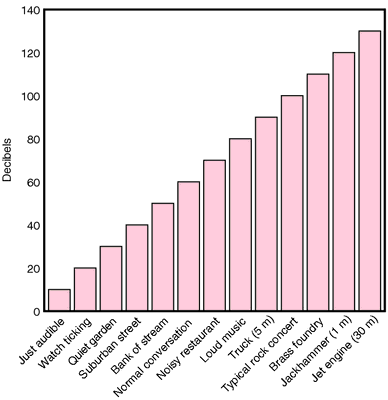decibel
[des´ĭ-bel]a unit of relative power intensity equal to one tenth of a bel, used for electric or acoustic power measurements; one decibel equals approximately the smallest difference in acoustic power the human ear can detect and an increase of 10 decibels approximately doubles the loudness of a sound. Abbreviated dB or db.

Examples of decibel levels in everyday situations. From Frazier et al., 1996.
Miller-Keane Encyclopedia and Dictionary of Medicine, Nursing, and Allied Health, Seventh Edition. © 2003 by Saunders, an imprint of Elsevier, Inc. All rights reserved.
dec·i·bel (dB, db),
(des'i-bel), Avoid the mispronunciation des'i-b'l.One tenth of a bel; unit for expressing the relative intensity of sound on a logarithmic scale.
[L. decimus, tenth, + bel]
Farlex Partner Medical Dictionary © Farlex 2012
dec·i·bel
(dB) (des'i-bĕl)One tenth of a bel; unit for expressing the relative loudness of sound on a logarithmic scale.
[L. decimus, tenth, + bel]
Medical Dictionary for the Health Professions and Nursing © Farlex 2012
decibel
A logarithmic unit of comparison between a standard power level and an observed level. The decibel is not a unit of sound intensity but is widely used to compare a noise level with a very low standard reference level near the limit of audibility, and to compare electrical power levels. A tenth of a bel.Collins Dictionary of Medicine © Robert M. Youngson 2004, 2005
Decibel
A unit of measure for expressing the loudness of a sound. Normal speech is typically spoken in the range of about 20-50 decibels.
Mentioned in: Audiometry, Hearing Loss
Gale Encyclopedia of Medicine. Copyright 2008 The Gale Group, Inc. All rights reserved.
decibel (dB)
1. Unit used for the measurement of the intensity of a sound. 2. Light intensities are often presented on a logarithmic (rather than linear) scale. This is done, in particular, to abbreviate large numbers. Moreover, it has become common, especially in perimetry, to use decibels rather than log units. A decibel scale is a logarithmic scale where 10 decibels are equal to 1 log unit; 20 decibels, to 2 log units, etc. In perimetry, decibels are used to indicate the attenuation of brightness of the stimulus. Thus, a 20 dB stimulus is equal to one-tenth the brightness of a 10 dB stimulus.
Millodot: Dictionary of Optometry and Visual Science, 7th edition. © 2009 Butterworth-Heinemann
dec·i·bel
(dB) (des'i-bĕl)One tenth of a bel.
[L. decimus, tenth, + bel]
Medical Dictionary for the Dental Professions © Farlex 2012